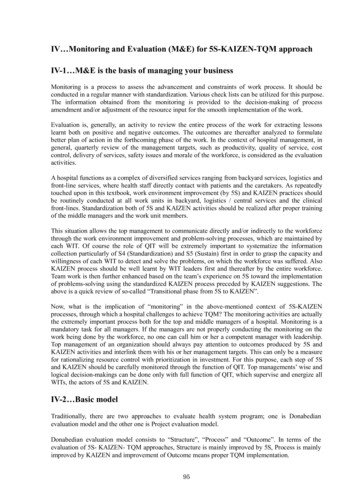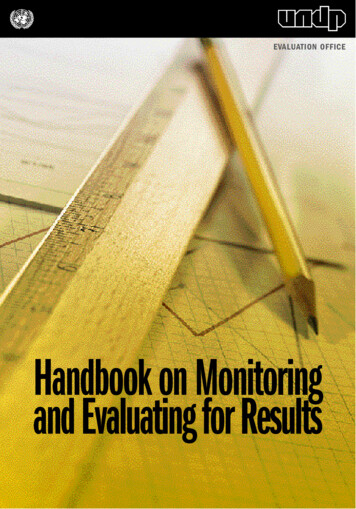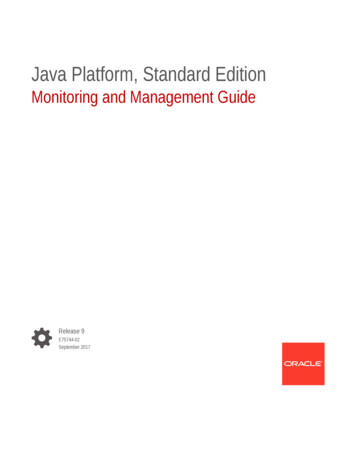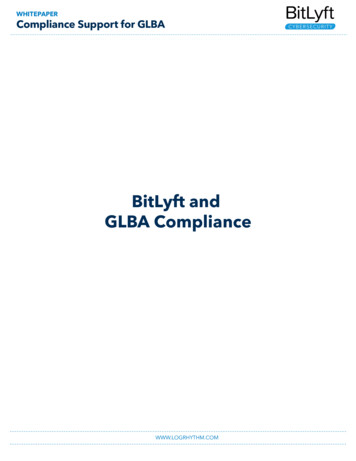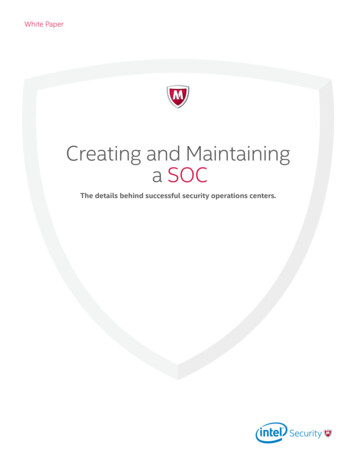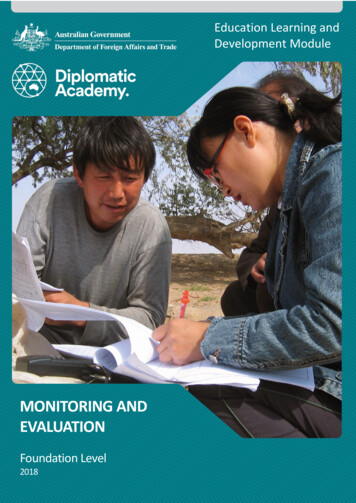
Transcription
Education Learning andDevelopment Module)MONITORING ANDEVALUATIONFoundation Level2018
MONITORING AND EVALUATION – FOUNDATION LEVELCONTENTSAcronyms . 31Introduction . 42Monitoring and evaluation: what do they mean? . 43Program logic/theory of change . 54Monitoring and evaluation frameworks . 65What should we monitor in education programs? . 66What should we evaluAte in education programs? . 77The ‘DAC Principles’ . 88Issues in education monitoring and evaluation. 109Education program evaluations . 1110Summary: being ‘aware’ of monitoring and evaluation . 1211Test your knowledge. 13References and links. 152
MONITORING AND EVALUATION – FOUNDATION LEVELACRONYMSDACDevelopment Assistance Committee (OECD)DFATAustralian Government Department of Foreign Affairs and TradeEFAEducation for AllGERgross enrolment rateJCSEEJoint Committee on Standards for Educational EvaluationM&Emonitoring and evaluationMELmonitoring, evaluation and learningNERnet enrolment rateNIRnet intake rateODEOffice of Development EffectivenessOECDOrganisation for Economic Co-operation and DevelopmentSDGsSustainable Development GoalsUISUNESCO Institute of StatisticsUNESCOUnited Nations Educational, Scientific and Cultural Organization3
MONITORING AND EVALUATION – FOUNDATION LEVEL1 INTRODUCTIONThe purpose of this module is to provide introductory information about monitoring andevaluation (M&E), including the purpose, application of M&E frameworks, and key issuesin education M&E. It provides a foundation to engage in this topic and apply advice fromstaff with operational or expert levels of knowledge in education M&E.2 MONITORING AND EVALUATION:WHAT DO THEY MEAN?Monitoring and evaluationMonitoring is the regular collection and analysis of informationto provide indicators of progress towards objectives. It includesmonitoring inputs, activities, outputs and progress towardsoutcomes. Monitoring answers the question: ‘What is going on?’Evaluation is assessment of a planned, ongoing or completed activity to assess theachievement of objectives as well as testing underlying theory of change assumptions.Evaluation answers the question: ‘What happened?’Applying M&E practicesMonitoring and evaluation have a complementary relationship. Monitoring givesinformation on the status of a policy, program, or project at any given time relative torespective targets and outcomes. Evaluation gives evidence of why targets and outcomeshave (or have not) been achieved.Monitoring and evaluation can be used for a wide range of purposes, including trackingexpenditure, revenues, staffing levels, and goods and services produced. M&E is a keyelement of development assistance, to understand and track mutual contributions to apartnership. This is defined in DFAT’s Aid Programming Guide.Importantly, M&E needs to be considered, and defined before the start of any activity sothat it can provide the evidence required to make assessments of program performance.Key guidelines for developing M&E are provided in the DFAT Monitoring and EvaluationStandards.Sources: DFAT 2017a; DFAT 2017b.4
MONITORING AND EVALUATION – FOUNDATION LEVELPurpose of M&EMonitoring and evaluation is an essential tool of management, extending to almost everyaspect of public sector activity, including development. There are multiple purposes ofM&E. It provides a basis for accountability to stakeholders. When reported clearly, M&Eprocesses and outcomes help identify shared learning about a range of areas, includinggood practice, effective strategies and tools, and information about specific issues. M&Esupports well-informed management through evidence-based decision making. All donors,bilateral and multilateral, conduct a large array of performance assessments at all stages ofproject or program cycles as part of their ongoing commitment to M&E. Donors also tendto align M&E to higher level, global commitments.The Sustainable Development Goals (SDGs) and Education for All (EFA) Goals are probablythe best-known M&E mechanisms in development. The SDG and EFA indicators specifytime-based goals to improve social and economic conditions in developing countries.SDG 4 sets out the goal to ensure inclusive and quality education for all and promotelifelong learning. Specific indicators of enrolment and primary completion are evaluated toassess progress towards that goal.The Australian aid program uses M&E to underpin its overall policy setting. MakingPerformance Count: Enhancing the Accountability and Effectiveness of Australian Aidarticulates the high-level priorities, broad programs and specific investments. This policydirective provides a credible and effective system for overseeing the performance of theAustralian aid effort.Sources: United Nations 2017; DFAT 2014.3 PROGRAM LOGIC/THEORY OF CHANGEDeveloping a theory of changeMonitoring and evaluation is applied differently in different contexts and investments,however most DFAT M&E is based on an evidence-based theory of change.A theory of change defines the sequence of elements required to achieve the program’sgoal and objectives. It is usually presented visually as the program logic. The theory ofchange is an important determinant of M&E. It sets out the hierarchy of inputs andintended outputs and outcomes including the links to the higher-level intentions, all ofwhich provide a measurement frame.Activities involve the processes of management and support. Outputs are the tangibleproducts of the activities that are within the control of the program to deliver. Outcomesdescribe an end state, how things are, rather than how they are achieved.Importantly, for education programs, the theory of change will usually seek to determinelinks between activities and the associated outcomes from them. It is generally assumedthat activities will contribute to outcomes, which are also influenced by a range of otherfactors.5
MONITORING AND EVALUATION – FOUNDATION LEVEL4 MONITORING AND EVALUATIONFRAMEWORKSComponents of an M&E frameworkThe theory of change enables the formulation of key M&E questions which will in turndirect M&E activity to provide information along specific lines of enquiry. This will ensureevidence is provided to report on the effectiveness or otherwise of programimplementation.An M&E framework presents the desired goals, results and/or impacts to be achieved andestablishes realistic measures, called indicators, against these. It presents the logicalordering of inputs, activities, indicators, targets, outcomes and impacts as detailed in thetheory of change. Increasingly, M&E frameworks are being referred to as Monitoring,Evaluation and Learning (MEL) Frameworks.The M&E framework provides detail around how the evidence of success would beassessed for each evaluation question and theory of change element with a correspondingmeans of verification. The M&E framework will usually also include information around:baseline data, M&E activity reporting timeframes; relevant data sources; datadisaggregation; and responsibility for data collection. Performance indicators are usuallydisaggregated by gender, social inclusion status and other variables to provide evaluativeinsights to inclusion.For an example of an education program M&E framework see Ten steps to a results-basedmonitoring and evaluation system: a handbook for development practitioners.Source: Kusek & Rist 2004.5 WHAT SHOULD WE MONITOR INEDUCATION PROGRAMS?MonitoringRobust M&E systems are an essential part of every aid investment made by the AustralianGovernment. These systems need to collect, analyse and feedback information to decisionmakers. There is an increasing focus on real-time availability of data to improve educationprogram performance management, rather than waiting for mid-term or end-of-programreview points.Program M&E should be agreed with partners and should reflect the planning cycle of thepartner country. Importantly, wherever possible data on indicators should be aligned to, ifnot collected within, partner government data systems.Typically, M&E for education projects will include common approaches to understand andcompare the general level of participation in education and capacity of primary education.6
MONITORING AND EVALUATION – FOUNDATION LEVELThe key indicators are the gross enrolment rate, net enrolment rate and assessments ofeducational access. Each of these indicators is discussed below:Gross Enrolment Rate (GER)The GER is the total enrolment within a country of a specificlevel of education, regardless of age, expressed as a percentageof the population in the official age group corresponding to thislevel of education. For example, if a nation has 900,000 peopleenrolled in school in the academic year 2016-17, this number is divided by the totalnumber of school-age individuals. Suppose this number is 1,000,000. This means 90 percent of the people are enrolled; or that 90 per cent is the GER of that nation. GER canexceed 100 per cent due to the inclusion of over-aged and under-aged studentsbecause of early or late entrants and grade repetition.Net Enrolment Rate (NER)The NER is the total enrolment of the official age-group for a given level of educationexpressed as a percentage of the corresponding population. For example, in 2014,Liberia had the worst measured NER in primary education in the world at 38 per cent.Thus, out of every 100 children within the official age-group for primary education, only38 were enrolled in school.Assessments of educational accessAssessments of educational access should go beyond GER and NER. For a more nuancedunderstanding of education access and participation, monitoring needs to include theGrade One net intake rate (NIR), measures of attendance by grade level, and theprimary completion rate, among other indicators.Sources: UIS 2017a; 2017b; UIS 2017c Liberia: Participation in education.6 WHAT SHOULD WE EVALUATE INEDUCATION PROGRAMS?Five key stages of education program activity evaluationThe Aid Programming Guide highlights the importance of evaluation. See Chapter 3: Aidprogram management and performance reporting; Chapter 4: Investment management,evaluation and quality reporting; and Chapter 5: Investment.There are five key stages of education program activity when it is important to carry outevaluation:7
MONITORING AND EVALUATION – FOUNDATION LEVEL1.At program preparation stage – to consider other similar program evaluations andlessons to be drawn from them.2.In the design stage – to ensure objectives are clear and baseline data is collected. It isimportant to record evaluation questions that emerge during the design.3.During implementation – targeted evaluations to assess progress against objectives,sometimes along thematic lines of enquiry.4.At completion – to see if the program has achieved expected objectives andoutcomes, and assess value for money.5.Post-program – to assess ongoing impact and sustainability of benefits from theprogram, usually to inform an evidence base for other program preparation.For more detail on the Australian aid program’s approach to M&E, see the Strategy forAustralia’s Aid Investments in Education 2015–2020. The strategy has specific implicationsfor evaluation. DFAT’s Performance Assessment Note can also provide additionalinformation.Sources: DFAT 2017a; DFAT 2015.7 THE ‘DAC PRINCIPLES’The DAC Principles for evaluation of development assistanceThe Development Assistance Committee was established by the Organisation for EconomicCooperation and Development (OECD-DAC) to improve development cooperation betweenits member governments and governments of developing or transitional countries.In 1991, the OECD-DAC released Principles for Evaluation of Development Assistancedevising key evaluation criteria. These evaluation guidelines have proved remarkablyresilient and flexible, and have been updated over time. Donors, including the Australianaid program, have modified the criteria to suit their own perspectives. It is common torefer to the ‘DAC Principles’ as short-hand for these widely-accepted evaluation criteria.The DAC Principles are perhaps the most important, and longstanding, definitions in thefield of development M&E. Those that are used in the Australian aid program are: Relevance: the extent to which the aid activity is suited to the priorities andpolicies of the target group, recipient and development partner. In evaluating therelevance of a program or a project, it is useful to ask questions such as: To whatextent are the objectives of the program still valid? Are the activities and outputsof the program consistent with the overall goal and the attainment of itsobjectives? Effectiveness: a measure of the extent to which an aid activity attains itsobjectives. To what extent were the objectives achieved or are likely to beachieved? What were the major factors influencing the achievement or nonachievement of the objectives?8
MONITORING AND EVALUATION – FOUNDATION LEVEL Efficiency: efficiency measures the output, qualitative and quantitative, in relationto the inputs. It is an economic term which signifies that the aid uses the leastcostly resources possible in order to achieve the desired results. Impact: the positive and negative changes produced by a developmentintervention, directly or indirectly, intended or unintended. Relevant questionsare: What has happened as a result of the program or project? What realdifference has the activity made to the beneficiaries? Sustainability: sustainability is concerned with measuring whether the benefits ofan activity are likely to continue. To what extent did the benefits of a program orproject continue after development partner funding ceased?Source: Development Assistance Committee 1991.The DAC Principles and the Australian aid programAustralian aid performance M&E systems generally exclude ‘impact’, although as a greaterresults-focus is adopted, aspects of ‘impact’ principles have relevance. The Australian aidprogram has also added additional criteria: Monitoring and evaluation: whether an appropriate system is being used to assessprogress towards meeting objectives. Analysis and learning: whether the aid activity is based on sound technical analysisand continuous learning. Gender equality: whether the aid activity is making a difference to gender equalityand empowering women and girls. Alignment with key policy priorities: whether the aid activity is aligned with policypriorities in disability, indigenous peoples and/or ethnic minorities, climate changeand disasters, private sector, and innovation.How are the DAC Principles applied?The DAC Principles remain largely unchanged, but the way they are applied has changed.When the DAC Principles were formulated (1991), M&E was largely aimed at good aidmanagement and administration. Now, there is a focus on results and outcomes.The results-based approach explicitly incorporates strategic priorities into evaluation. Thisenables the assessment of expenditure and inputs of a program in achieving desiredoutcomes. Results-based M&E focuses on outcomes and impact. As such, the Australianaid program asks whether programs or policies have produced their intended results.The lesson has gradually been learned that increasing enrolments is not equivalent toimprovements in learning. There has been movement away from measuring simpleenrolments to measuring primary school completion, academic achievement and ability toprogress to further study and ultimately employment. The focus on implementation(inputs leading to outputs) is changing to a results-oriented approach, with an emphasis onoutcomes.9
MONITORING AND EVALUATION – FOUNDATION LEVELDeveloping indicators for equity and accessThere is still much work to be done on developing indicators for different dimensions ofequity and access, but it is increasingly common to report the Gender Parity Index – theratio of female to male enrolments at a given level of schooling.8 ISSUES IN EDUCATION MONITORINGAND EVALUATIONPotential difficultiesThere are potential difficulties at any stage of M&E in education programs and activities,including: M&E may not be built in to activities or programs indicators and other measures may be poorly specified a lack of reliable and valid data a lack of access to M&E respondents incomplete data – including no baseline information limited capacity in data analysis M&E systems may be generally set up to include a focus on results, but evaluations ofprojects or programs tend to default to a model of evaluating inputs, activities and outputs education outcomes have not been well defined in the M&E system, cannot be measured, andcannot be reliably, and sensitively, understood.When do these difficulties become apparent?Difficulties in M&E usually arise when there is very little reference given to M&E during theproject/program planning, implementing and reviewing cycle. Poor M&E is usuallyevidenced in poorly defined measures and procedures, unclear data collection methods,limited access to evidence and data and little attention given to the impact of the activity.An M&E plan, based on the 2017 DFAT M&E Standards, establishes a clear way to defineM&E criteria, processes, outputs, timeframes, roles and responsibilities at the outset for awell-managed program or activity.Those responsible for M&E should assert themselves at the commencement of a program,ensure that the measures and processes they are using are understood and agreed with, andare supported by reliable data by accessing or creating relevant data sources.M&E specialists should also see it as part of their roles to, where needed, strengthen thecapacities of local staff to build their M&E skills, particularly in data verification and analysis.Source: DFAT 2017b.10
MONITORING AND EVALUATION – FOUNDATION LEVELAttribution versus contributionAttribution seeks to identify how a given activity specifically resulted in an identifiedoutcome. Attribution is easier to establish when there is a clear causal relationshipbetween the outcome and any preceding outputs. For example, that immunising childrenresulted in fewer cases of that disease.In education, attribution is difficult to establish, as it is hard to identify the specific factorthat resulted in an outcome. For example, are children performing better in standardisedtests because of teacher training, or the availability of textbooks, or changes to the schoolcurriculum?As mentioned earlier, program designs and theories of change do not generally seek toidentify the causal relationships necessary to establish attribution (i.e. this input causedthat outcome). Instead activities are linked to outcomes, to establish their contribution toa positive change (i.e. this activity, along with several others, contributed to thatoutcome).The Australian aid program can rarely claim that a given activity exclusively caused anoutcome (attribution). Rather, investments typically contribute to outcomes(contribution).9 EDUCATION PROGRAM EVALUATIONSAn evaluation can address a specific education project or cover a whole education sectorprogram. The type of evaluation choice will depend on the context, timing, resources andquestions that need to be answered. Strategic evaluations are independently initiated and managed by the Office ofDevelopment Effectiveness (ODE). They are broad assessments of Australian aidthat focus on policy directions or specific development themes. They typicallyexamine a number of investments, often across multiple countries, regions orsectors. Program evaluations are initiated and managed by program areas, such as countryand sector programs. Each education program undertakes an annual process toidentify and prioritise a reasonable number of evaluations which they can use toimprove its work. Programs may also be required to conduct thematic evaluation,mid-term reviews, or an Independent Completion Report as part of the DFATquality assurance framework.Some examples include:In 2015, ODE undertook an evaluation of teacher development approaches titledInvesting in Teachers. The evaluation, together with the Supporting TeacherDevelopment: Literature Review, provides evidence for improving teacher developmentprograms. It examines 27 bilateral Australian aid investments in teacher developmentfrom 2009 to 2015.11
MONITORING AND EVALUATION – FOUNDATION LEVELIn 2016, the Education Team in Indonesia commissioned the Independent CompletionReport for the Education Partnership. The Report describes the partnership’s evolution,captures its significant achievements and reports the program’s performance, bycomponent, against the DAC criteria. It also looks at value for money and provideslessons for future programs.Sources: ODE 2015; Reid et al. 2015, ODE 2016; DFAT 2016.10 SUMMARY: BEING ‘AWARE’ OFMONITORING AND EVALUATION There are many ways of doing M&E, including managing for results, use ofperformance indicators and impact evaluations. These approaches are all based on the principle of trying to relate inputs andactivities to outcomes, and to get the best value for money. M&E is best considered an approach rather than a specific technique. M&E is fundamentally a system of performance assessment. M&E needs to be built into an activity at the design stage.12
MONITORING AND EVALUATION – FOUNDATION LEVEL11 TEST YOUR KNOWLEDGEAssessment questionsAnswer the following questions by ticking ‘True’ or ‘False’. Once you have selected youranswers to all the questions, turn the page to ‘The correct answers are.’ to check theaccuracy of your answers.Question 1The DAC Principles have changed since they were developed in 1991.Is this statement true or false? True FalseQuestion 2An M&E system can be described as a performance assessment framework.Is this statement true or false? True FalseQuestion 3We do not need indicators at every level of monitoring and evaluation.Is this statement true or false? True FalseQuestion 4An M&E system should be designed and built into an aid activity from the very beginning.Is this statement true or false? True FalseQuestion 5Support from the Australian aid program shows its contribution to outcomes.Is this statement true or false? True False13
MONITORING AND EVALUATION – FOUNDATION LEVELThe correct answers are.Question 1The DAC Principles have changed since they were developed in 1991.This statement is false. The DAC Principles are largely unchanged, but the way they areapplied has changed.Question 2An M&E system can be described as a performance assessment framework.This statement is true.Question 3We do not need indicators at every level of monitoring and evaluation.This statement is false. We do need indicators at every level of M&E, although we shouldbe careful to select a few good indicators, rather than having too many. Indicators are atthe heart of M&E to measure what we are doing and to tell us whether we are on track toachieve our goals.Question 4An M&E system should be designed and built into an aid activity from the very beginning.This statement is true. If the necessary M&E elements are not incorporated at the outset,such as baseline data, it will be very difficult to monitor progress or evaluate the programat the end.Question 5Support from the Australian aid program shows its contribution to outcomes.This statement is true. Support from the Australian aid program usually does not claimthat a given activity exclusively causes an outcome (attribution). Australian aid programsupport typically contributes to outcomes (contribution).14
MONITORING AND EVALUATION – FOUNDATION LEVELREFERENCES AND LINKSAll links retrieved July, 2018.Department of Foreign Affairs and Trade (DFAT) 2014, Making performance count:Enhancing the accountability and effectiveness of Australian aid, June, ments/framework-making-performancecount.pdf2015, Strategy for Australia’s aid investments in education 2015 -2020, September,DFAT, on-2015-2020.pdf2016, Education partnership – independent completion report: Performance oversightand monitoring (POM), December, DFAT, pdf2017a, Aid programming guide, March, DFAT, aid-programming-guide.pdf2017b, DFAT Monitoring and evaluation standards, April, t Assistance Committee 1991, Principles for evaluation of developmentassistance, OECD, 5.pdfKusek J & Rist R 2004, Ten steps to a results-based monitoring and evaluation system: Ahandbook for development practitioners, World 986/14926Office of Development Effectiveness (ODE) 2015, Investing in teachers, December, dfOffice of Development Effectiveness (ODE) 2016, Teacher development, 20 May, ance/ode/other-work/Pages/teacherquality.aspxReid, K, Kleinhenz, E & Australian Council for Educational Research 2015, Supportingteacher development: Literature review, DFAT, ature-review.pdfUNESCO Institute for Statistics (UIS) 2017a, ‘Gross enrolment rate’, oss-enrolment-ratio2017b, ‘Net enrolment rate’, Glossary, UNESCO, t-rate2017c, Liberia: participation in education; Education and literacy, data for theSustainable Development Goals, http://uis.unesco.org/en/country/lr15
MONITORING AND EVALUATION – FOUNDATION LEVELUnited Nations 2017, Goal 4: Ensure inclusive and quality education for all and promotelifelong learning, Sustainable Development Goals, ion/Learn more about The DAC principles for development evaluation assistance, found orevaluatingdevelopmentassistance.htmDFAT aid evaluation policy 2016, found at: dfJoint Committee on Standards for Educational Evaluation (JCSEE) accepted internationalstandards, found at: ECD’s principles for evaluating development cooperation, found 2905.pdfOECD-DAC’s 2002, Glossary of key terms in evaluation and results-based management,found at: CO’s 2016 Global Education Monitoring (GEM) Report: UNESCO 2016, Education forpeople and planet: Creating sustainable futures for all, 2016 Global Education MonitoringReport, found at: 5e.pdfWorld Bank 2004, Influential evaluations: Evaluations that improved performance andimpacts of development programs, found /Resources/45856721251727474013/influential evaluations ecd.pdfWorld Bank 2004, Monitoring & evaluation: Some tools, methods & approaches, found /Resources/45856721251481378590/MandE tools methods approaches.pdf16
Evaluation answers the question: What happened? Applying M&E practices Monitoring and evaluation have a complementary relationship. Monitoring gives information on the status of a policy, program, or project at any given time relative to respective targets and outcomes. Evaluation gives evidence of why targets and outcomes
